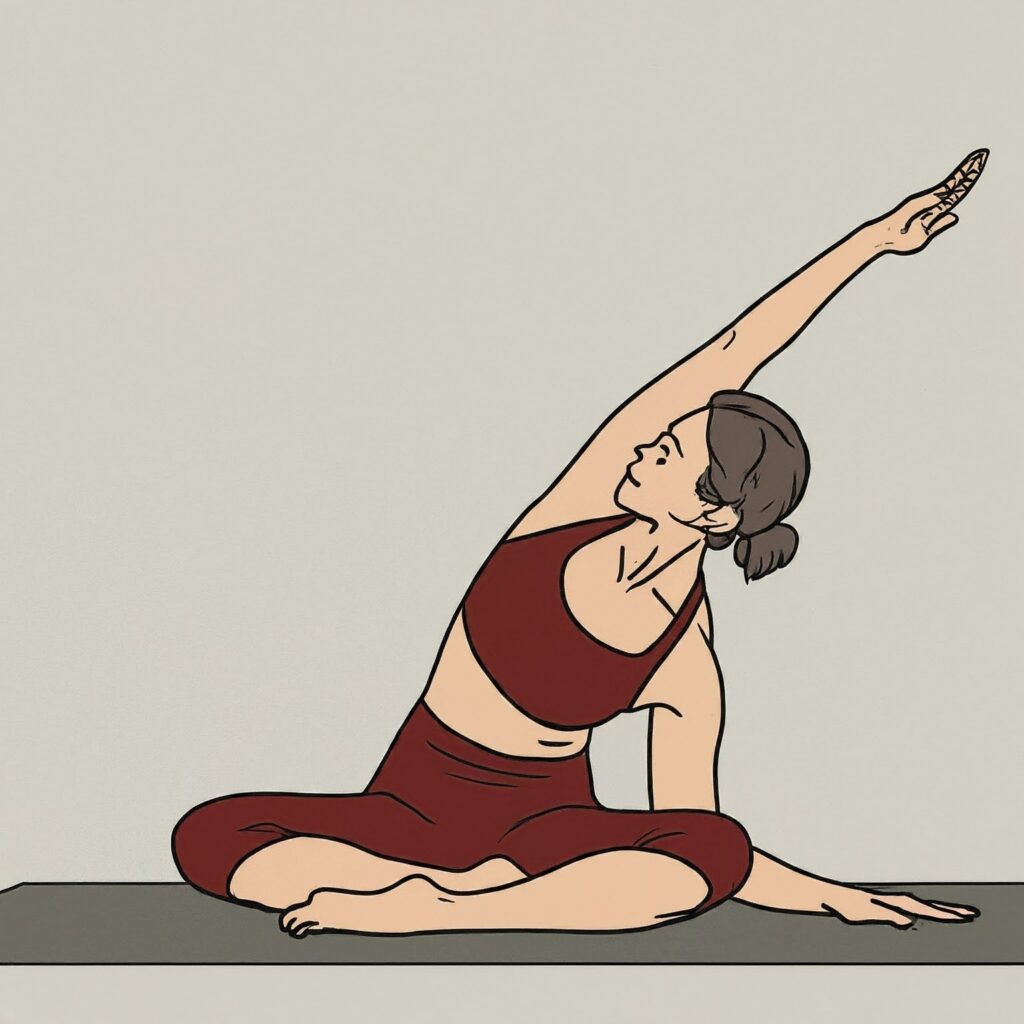Parsva Sukhasana, also known as Easy Side Pose, is a gentle yet deceptively potent yoga posture. As the name suggests, it’s accessible to beginners but offers rich benefits for yogis of all levels. Imagine sitting cross-legged, then gently extending one leg out to the side and reaching your torso over the extended leg. That’s essentially Parsva Sukhasana – a beautiful blend of side bend, twist, and grounding.This pose targets the hips, inner thighs, and spine, promoting flexibility, reducing tension, and improving overall well-being.
“Sometimes, the easiest poses hold the most profound benefits.”
– Unknown Yogi.
Today, we explore Parsva Sukhasana, a testament to this wisdom. Has your yoga routine become predictable? Do you yearn for a pose that stretches, invigorates, and leaves you feeling light as a feather? Look no further than Parsva Sukhasana, the deceptively simple “Easy Side Pose.” Don’t let the name fool you! This accessible posture offers surprising depth, unlocking a symphony of physical and mental well-being.
Benefits of Parsva Sukhasana
Parsva Sukhasana, or Side-Seated Pose, offers a multitude of benefits for both physical and mental well-being. Here’s a detailed exploration of its benefits:
1. Hip Flexibility:
Parsva Sukhasana effectively stretches the hips, releasing tension and increasing flexibility. This can be particularly beneficial for activities that require hip mobility, such as running, cycling, and dancing.
2. Spinal Health:
The pose helps to lengthen and align the spine, reducing stiffness and improving posture. It also strengthens the muscles that support the spine, promoting overall spinal health.
3. Sciatica Relief:
Parsva Sukhasana can help to relieve sciatica pain by stretching the piriformis muscle, which is often a contributor to this condition. The pose helps to release tension in the piriformis muscle, reducing pressure on the sciatic nerve and alleviating pain.
4. Stress Reduction:
The calming effect of Parsva Sukhasana can help to reduce stress and anxiety, promoting a sense of relaxation and inner peace. The deep breathing involved in the pose also helps to calm the mind and reduce the heart rate, contributing to stress reduction.
5. Improved Balance:
Regular practice of Parsva Sukhasana can improve balance and coordination by strengthening the core muscles and improving proprioception, the body’s ability to sense its position in space. This can be beneficial for activities that require good balance, such as yoga, martial arts, and sports.
6. Digestive Health:
Parsva Sukhasana can help to improve digestion by stimulating the abdominal organs and promoting blood flow to the digestive system. This can help to relieve digestive issues such as constipation and bloating.
7. Menstrual Pain Relief:
Parsva Sukhasana can help to relieve menstrual pain by relaxing the muscles in the lower abdomen and pelvis. The pose also helps to improve blood circulation in the pelvic region, which can help to reduce pain and discomfort.
8. Ankle and Knee Health:
Parsva Sukhasana can help to strengthen the ankles and knees, making them less susceptible to injuries. The pose also helps to improve flexibility in the ankles and knees, which can be beneficial for activities such as walking, running, and hiking.
How to do Parsva Sukhasana
Starting Position:
- Begin by sitting comfortably on the floor with your legs extended in front of you.
- Your spine should be straight and your shoulders relaxed.
- Your arms should be resting at your sides.
Bend Your Right Knee:
- Bend your right knee and bring your right foot towards your body.
- Place the sole of your right foot on the floor, just inside your left thigh.
- Your right knee should be pointing straight up towards the ceiling.
Cross Your Left Leg:
- Cross your left leg over your right leg, placing your left foot on the outside of your right thigh.
- Your left knee should be directly above your right knee.
- Make sure that your left foot is flat on the floor and that your toes are pointing forward.
Sit Up Tall:
- Sit up tall, lengthening your spine and drawing your shoulders back.
- Your chest should be lifted and your head should be in line with your spine.
Extend Your Arms:
- Extend your arms out to the sides, parallel to the floor.
- Your palms should be facing down and your shoulders should be relaxed.
Hold and Breathe:
- Hold the pose for 5-10 breaths, taking deep and steady breaths.
- Focus on lengthening your spine and relaxing your body.
Release and Repeat:
- To release the pose, slowly lower your arms and bring your legs back to the starting position.
- Repeat the pose on the other side, bending your left knee and crossing your right leg over your left.
Common Mistakes to Avoid in Parsva Sukhasana:
When practicing Parsva Sukhasana, it’s important to avoid certain common mistakes to ensure proper alignment and prevent injury. Here are some key mistakes to be mindful of:
1. Slouching:
Avoid slouching or rounding your shoulders. This can strain your neck and back, and reduce the effectiveness of the pose.
Keep your spine straight and your shoulders back, drawing your shoulder blades down and away from your ears.
2. Overstretching:
Don’t force yourself into the pose if you feel pain. Parsva Sukhasana should be a comfortable stretch, not a painful one.
Respect your body’s limitations and work gradually to increase your flexibility over time.
3. Incorrect Foot Placement:
Make sure that your feet are placed correctly to avoid putting strain on your knees and ankles.
Your right foot should be flat on the floor, with your heel close to your left buttock.
Your left foot should be crossed over your right thigh, with your toes pointing forward.
4. Holding Your Breath:
Remember to breathe deeply and continuously throughout the pose. Holding your breath can restrict oxygen flow and cause dizziness or lightheadedness.
Focus on taking slow, deep breaths, allowing your breath to flow naturally.
5. Rushing the Pose:
Avoid rushing into or out of the pose. Take your time to enter the pose slowly and carefully, and hold it for a few breaths before releasing.
Rushing can increase your risk of injury and reduce the benefits of the pose.
6. Ignoring Your Body’s Signals:
Pay attention to how your body feels during the pose. If you experience any pain or discomfort, come out of the pose and modify it as needed.
Pushing through pain can lead to injury and hinder your progress in the pose.
7. Practicing on an Uneven Surface:
Make sure to practice Parsva Sukhasana on a flat, even surface to avoid losing your balance and injuring yourself.
Avoid practicing on slippery or uneven surfaces, such as a wet floor or a yoga mat that is not properly secured.
Tips for Practicing Parsva Sukhasana:
To get the most out of Parsva Sukhasana and avoid discomfort or injury, here are some helpful tips to keep in mind:
Warm Up Properly:
Before practicing Parsva Sukhasana, warm up your body with some gentle movements, such as walking, jogging, or dynamic stretches.
This will help to prepare your muscles for the pose and reduce the risk of injury.
Use Props if Needed:
If you have tight hips or difficulty sitting up tall with your spine straight, use props to support yourself.
You can place a block or blanket under your sitting bones to elevate your hips, or use a strap to help you cross your legs.
Focus on Your Breath:
Throughout the pose, focus on taking slow, deep breaths.
Allow your breath to guide you into a deeper stretch and help you to relax and release tension.
Hold for the Right Amount of Time:
Hold the pose for a comfortable amount of time, typically 30 seconds to a minute.
Gradually increase the hold time as you become more comfortable and flexible.
Listen to Your Body:
Pay attention to how your body feels during the pose. If you experience any pain or discomfort, come out of the pose and modify it as needed.
Pushing through pain can lead to injury and hinder your progress in the pose.
Modify the Pose as Needed:
There are many variations of Parsva Sukhasana that you can try to make the pose more accessible and comfortable.
For example, you can try Ardha Parsva Sukhasana (Half Side-Seated Pose), where you only cross one leg over the other, or you can place a block between your thighs for support.
Practice Regularly:
Regular practice is key to improving your flexibility and getting the most benefits from Parsva Sukhasana.
Aim to practice the pose at least a few times per week to see significant improvements in your flexibility and range of motion.
Read Also – How Yoga help in preventing disease?
FAQs:
What are the benefits of Parsva Sukhasana for athletes?
Parsva Sukhasana can improve flexibility in the hips and spine, which is beneficial for athletes in sports such as running, cycling, and dancing. It can also help to relieve sciatica pain, which is common in athletes.
Can Parsva Sukhasana help to improve posture?
Yes, Parsva Sukhasana can help to improve posture by lengthening and aligning the spine. It can also help to strengthen the core muscles, which contribute to good posture.
Is Parsva Sukhasana safe for beginners?
Yes, Parsva Sukhasana is generally safe for beginners. However, it’s important to start slowly and gradually increase the hold time. If you have any injuries or concerns, consult with a yoga teacher before practicing this pose.
What are some variations of Parsva Sukhasana?
There are several variations of Parsva Sukhasana, including Ardha Parsva Sukhasana (Half Side-Seated Pose) and Parsva Sukhasana with a twist. These variations allow you to modify the pose to suit your needs and abilities.
Can Parsva Sukhasana help to reduce stress and anxiety?
Yes, Parsva Sukhasana can help to reduce stress and anxiety by calming the mind and promoting relaxation. The deep breathing involved in the pose also helps to reduce the heart rate and blood pressure, which can have a calming effect.







